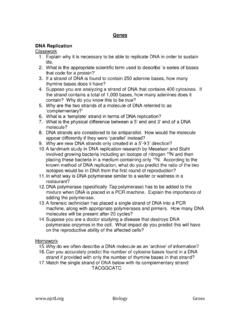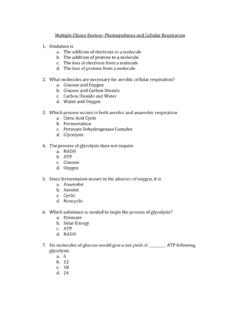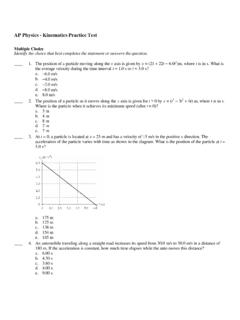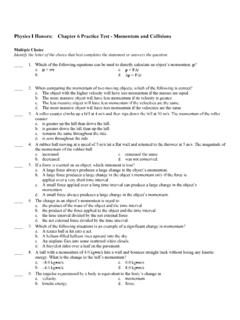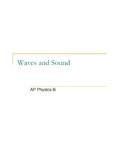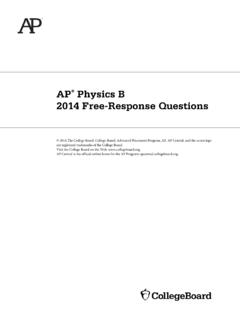Transcription of Thermodynamics - Center For Teaching & Learning
1 Thermodynamics AP physics B Name_____ Multiple Choice Questions 1. What is the name of the following statement: When two systems are in thermal equilibrium with a third system, then they are in thermal equilibrium with each other ? (A) First Law of Thermodynamics (B) Second Law of Thermodynamics (C) Mechanical equivalent of heat (D) Zeroth Law of Thermodynamics (E) Thermal expansion of solids 2. An aluminum plate has a circular hole. If the temperature of the plate increases, what happens to the size of the hole?
2 (A) Increases (B) Decreases (C) Stays the same (D) Increases the top half of the hole (E) More information is required 3. A bimetal plate consists of two materials of different coefficients of thermal expansion. The coefficient of thermal expansion of the top part of the plate is less than the bottom part. If the temperature of the entire plate increases, what happens to the plate? (A) Expends (B) Contracts (C) Stays the same (D) Bends down (E) Bends up 4. Which of the following temperature scales doesn t have negative numbers?
3 (A) Celsius (B) Kelvin (C) Reaumur (D) Fahrenheit (E) Galileo 5. Which of two temperature change are equivalent? (A) 1 K = 1 F (B) 1 F = 1 C (C) 1 Re = 1 F (D) 1 K = 1 C (E) 1 Re = 1 K 6. The state of an ideal gas was changed three times at three different temperatures. The diagram represents three different isothermal curves. Which of the following is true about the temperature of the gas? (A) T1 > T2 > T3 (B) T1 > T2 < T3 (C) T1 < T2 < T3 (D) T1 > T2 = T3 (E) T1 = T2 > T3 7. A container filled with a sample of an ideal gas at the pressure of atm.
4 The gas is compressed isothermally to one-fourth of its original volume. What is the new pressure of the gas? (A) 2 atm (B) 3 atm (C) 4 atm (D) 5 atm (E) 6 atm 8. The state of an ideal gas was changed three times in a way that the pressure stays the same. The graph represents three isobaric lines. Which of the following is true about the pressure of the gas? (A) P1 > P2 > P3 (B) P1 > P2 < P3 (C) P1 < P2 < P3 (D) P1 = P2 > P3 (E) P1 > P2 = P3 9. The temperature of an ideal gas increases from 20 C to 40 C while the pressure stays the same.
5 What happens to the volume of the gas? (A) It doubles (B) It quadruples (C) It is cut to one-half (D) It is cut to one-fourth (E) it slightly increases 10. The state of an ideal gas was changed three times in a way that the volume stays the same. The graph represents three isobaric lines. Which of the following is true about the volume of the gas? (A) V1 >V2 >V3 (B) V1 > V2 < V3 (C) V1 < V2 < V3 (D) V1 = V2 > V3 (E) V1 > V2 = V3 11. A container with rigid walls filled with a sample of ideal gas. The absolute temperature of the gas is doubled.
6 What happens to the pressure of the gas? (A) Doubles (B) Quadruples (C) Triples (D) Decreased to one-half (E) Decreased to one-fourth 12. The absolute temperature of an ideal diatomic gas is quadrupled. What happens to the average speed of molecules? (A) Quadruples (B) Doubles (C) Triples (D) Increases by a factor of (E) Stays the same 13. Two containers are filled with diatomic hydrogen gas and diatomic oxygen gas. The gases have the same temperature. Compare the average speed of hydrogen molecules to the average speed of oxygen molecules.
7 (A) 1/16 (B) 1/4 (C) 16/1 (D) 1/2 (E) 4/1 14. The average molecular kinetic energy of a gas depends on: (A) Pressure (B) Volume (C) Temperature (D) Number of moles (E) None of the above 15. Kinetic Theory is based on an ideal gas model. The following statements about the ideal gas are true EXCEPT: (A) The average molecular kinetic energy is directly proportional to the absolute temperature (B) All molecules move with the same speed (C) All molecules make elastic collisions with each other and the walls of the container (D) The attractive force between the molecules can be ignored (E) All molecules obey laws of classical mechanics 16.
8 Internal energy of an ideal gas depends on: i. the volume of the ideal gas ii. the pressure of the ideal gas iii. the absolute temperature of the ideal gas (A) I (B) II (C) III (D) I and II (E) I, II and III 17. A sample of ideal gas has an internal energy U and is then compressed to one-half of its original volume while the temperature stays the same. What is the new internal energy of the ideal gas in terms of U? (A) U (B) 1/2U (C) 1/4U (D) 2U (E) 4U 18.
9 An ideal gas with an internal energy U initially at 0 C is heated to 273 C. What is the new internal energy in terms of U? (A) U (B) 1/2U (C) 1/4U (D) 2U (E) 4U 19. Mechanical equivalent is associated with: (A) Newton (B) Kelvin (C) Joule (D) Boltzmann (E) Avogadro 20. Three containers filled with 1 kg of each: water, ice, and water vapor at the same temperature T = 0 C. Which of the following is true about the internal energy of the substances? (A) U water > U ice > U vapor (B) U water < U ice > U vapor (C) U water = U ice = U vapor (D) U water < U ice < U vapor (E) U ice < U water < U vapor 21.
10 A silver tea spoon is placed in a cup filled with hot tea. After some time, the exposed end of the spoon becomes hot even without a direct contact with the liquid. This phenomenon can be explained by: (A) Thermal expansion (B) Conduction (C) Convection (D) Radiation (E) Emission 22. The process of heat transfer from object to another because of molecular motion and interaction is called: (A) Convection (B) Conduction (C) Radiation (D) Induction (E) None of the above 23. A hot object with a temperature T1 is connected to a cool object with a temperature of T2.





